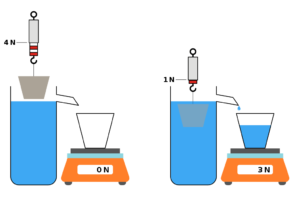Archimedes and the Golden Crown

The Story
Archimedes was a brilliant ancient Greek mathematician and scientist. He lived over 2,000 years ago in the city of Syracuse, which is now part of modern-day Italy.
One day, the king of Syracuse gave a goldsmith a piece of gold to make a beautiful crown. When the crown was finished, it looked perfect. However, the king had a suspicion that the goldsmith might have replaced some of the gold with cheaper metal.
The king wanted to find out if the crown was made entirely of gold, but he didn’t want to damage it. So, he turned to Archimedes for help. Archimedes put on his thinking cap and came up with a brilliant idea.
One day, as Archimedes was taking a bath, he noticed that the water level rose when he got in. He realized that he could use this observation to solve the problem of the crown. He was so excited that he jumped out of the bath and ran through the streets shouting, “Eureka!” which means “I have found it!”
Archimedes discovered that when an object is placed in water, it pushes the water aside and takes up space. He realized that if he compared the weight of the crown to the weight of the same amount of pure gold, he could find out if the crown was made of real gold or not.
Archimedes set up an experiment. He took a piece of pure gold and a container filled with water. He carefully placed the gold in the water and measured how much water overflowed. Then, he did the same thing with the crown. He found that the crown displaced more water than the gold of the same weight.
This meant that the crown was not made entirely of gold. The goldsmith had indeed replaced some gold with another metal. Archimedes had proved it without damaging the crown!
Thanks to Archimedes’ clever experiment, the king discovered the truth and took appropriate action. This story shows how Archimedes used his intelligence and creativity to solve a problem and help others. He is remembered as one of the greatest minds in history.
Archimedes checked the density of the crown and the amount of gold immersed in water later they found that the goldsmith had cheated them.
The science behind Archimedes’ Principle
The story of Archimedes and the Golden Crown demonstrates the scientific principle of buoyancy, which is a fundamental concept in physics.
Buoyancy is the upward force exerted on an object immersed in a fluid, like water. Archimedes noticed that when he got into the bath, the water level rose. This happens because his body pushes the water aside and takes up space, causing the water level to increase.
Archimedes realized that he could use this principle to determine if the crown was made entirely of gold or if it contained other metals. He knew that different materials have different densities, which determines how much space they take up and how heavy they are.
To test the crown, Archimedes compared its weight to the weight of an equal volume of pure gold. He did this by measuring how much water overflowed when he placed each object in a container filled with water. The amount of water displaced by an object is equal to the volume of the object.
If the crown was made entirely of gold, it would have the same density as pure gold, and the water displaced would be equal to the weight of the gold. However, if the crown contained other metals of lower density, it would displace more water than its weight in gold.
By comparing the water displacement of the crown to that of pure gold, Archimedes was able to determine that the crown was not made entirely of gold. This experiment provided a scientific basis for his conclusion and helped him uncover the truth about the crown.
Archimedes’ discovery of buoyancy and its application in this story showcases the power of observation, experimentation, and applying scientific principles to solve real-world problems. It highlights how science can help us uncover the truth and make informed decisions based on evidence.

Uses of Archimedes’ principle
Archimedes’ Principle has several practical applications in our daily lives and various fields. Here are a few examples:
- Ship and Submarine Design: Archimedes’ Principle is crucial in designing ships and submarines. By considering the buoyant force, engineers can determine the appropriate size and shape of the hull to ensure the vessel can float and carry its intended load.
- Buoyancy Control: The principle is used to control the buoyancy of objects in water. For example, scuba divers use buoyancy compensators to adjust their buoyancy and maintain a desired depth underwater.
- Hot Air Balloons: The science behind hot air balloons relies on Archimedes’ Principle. By heating the air inside the balloon, it becomes less dense than the surrounding air, causing the balloon to float upward.
- Hydrometers: Hydrometers are instruments used to measure the density or specific gravity of liquids. They work based on Archimedes’ Principle, where the buoyant force acting on the hydrometer relates to the density of the liquid being measured.
- Density-based Separation: Archimedes’ Principle is employed in various separation techniques. For instance, in wastewater treatment plants, solids and liquids can be separated based on their density using settling tanks or flotation devices.
- Submarines: Submarines use ballast tanks to control their buoyancy and depth underwater. By adjusting the amount of water or air in the tanks, submarines can either surface or dive, taking advantage of Archimedes’ Principle.
- Floating Objects: The principle helps explain why certain objects float in water, such as boats and life jackets. By displacing an amount of water equal to their weight, these objects experience an upward buoyant force that keeps them afloat.
These are just a few examples of how Archimedes’ Principle is applied in various fields, demonstrating its importance in understanding and manipulating the behavior of objects in fluids.
Definition of Archimedes’ Principle
Archimedes’ Principle is a scientific principle that explains the buoyant force experienced by objects submerged in a fluid. It states that an object immersed in a fluid experiences an upward force equal to the weight of the fluid it displaces. In simpler terms, it means that objects float or sink based on the relationship between their weight and the weight of the fluid they displace. This principle, discovered by the ancient Greek mathematician and scientist Archimedes, helps explain why some objects float in water while others sink.














